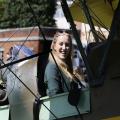AT the recent heritage day at St Edburg’s Church banners were displayed representing five Lords of the Manor, which had been made in 1944 at the request of the vicar, the Revd. Charles Paul Cowland-Cooper.
They hung in the nave but when removed a number of years ago were found to be in poor condition and were never re-hung.
It was therefore wonderful to see them again, as they illustrate an important part of the history of the town.
The crests belong to the families of Bassett, de Camville, Longespee, de Lacy and Le Strange, and it is interesting to note that the manor of Bicester was passed down largely through the marriages of the female line.
At the time of the Doomsday Book, in 1086, the manors of Bicester and Wretchwick belonged to a Norman baron, Robert d’Oily, but he gave them to Gilbert Bassett, who had married into his family.
Gilbert was a younger son of Ralph Bassett, chief justice of England, and was a generous benefactor to St Edburg’s Parish Church.
But it was his grandson, named after him, who made the biggest impact on Bicester.
It was this Gilbert Bassett who founded Bicester Priory in 1182, for a prior and 11 canons of the Order of St Augustine.
Gilbert was a knight and thought to have died abroad, possible on a crusade.
His widow Egeline was buried in the Priory Church, which was dedicated to St Mary & St Edburg, and the estate passed to Richard de Camville, who had married their only daughter.
Their daughter, in turn, married William Longespee, son of the Earl of Sailisbury, a very noble family.
Their son, also called William, then inherited and his daughter married Henry de Lacy, who became Earl of Lincoln.
Alice, their only daughter, had an unhappy and turbulent marriage to Thomas, Earl of Lancaster and, following their divorce, she married Eubolo Le Strange, with those family the estate remained for many years.
The priory complex stood to the south east of the current parish church, and consisted of a large number of buildings, a cloister and huge church as well as much surrounding land.
At the dissolution of the monasteries in 1536, the ‘manor’ reverted to the crown.
King Henry VIII gave it Charles Brandon, Duke of Suffolk, a close friend who had married his sister Mary Tudor, Queen of France, but he sold it on to Roger Moore and his family.
The priory must have been much missed.
It had not only provided a place of worship for the people of Bicester, but also education, health care, entertainment and, most importantly, employment.
After its demise, it became known as ‘The Old Place’, and is today called Old Place Yard.
The local historian John Dunkin undertook the first excavations there in 1819 and several have been done since.
It remains of important historical and archaeological interest – and all due to Gilbert Bassett junior, so it is right we celebrate him, and those who succeeded him in providing our town with a rich heritage.
A leaflet containing the original notes of the Revd. Cowland-Cooper about the families represented on the banners can be obtained from St Edburg’s Church.











Comments: Our rules
We want our comments to be a lively and valuable part of our community - a place where readers can debate and engage with the most important local issues. The ability to comment on our stories is a privilege, not a right, however, and that privilege may be withdrawn if it is abused or misused.
Please report any comments that break our rules.
Read the rules here